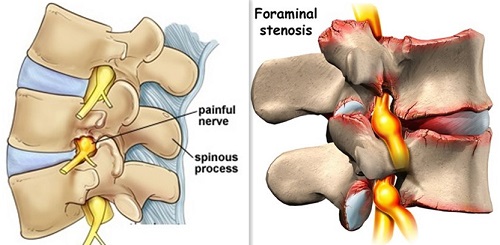In the spinal column, the small openings that nerve roots run through are referred to as the foramina. Narrowing of the foramina (stenosis) results innerve roots compression, which is also referred to as foraminal stenosis or neural foraminal narrowing. Foraminal stenosis may affect a single nerve root on one side of the body or have a bilateral effect resulting in nerve root compression on both sides of the patient's spine.
Symptoms of Neural Foraminal Stenosis
The symptoms of stenosis vary with the severity of the disease, the original width of the spinal canal, the vulnerability of the nerves involved, etc. Here are some common symptoms of the disease.
- Pain in the buttocks, thigh and legs while standing or walking, and dissipation of the pain while resting. You may or may not have back pain.
- Certain positions and movements may alleviate or reduce your pain, such as flexion or bending because they can give more space to the nerve root.
- Tingling, numbness and weakness in the lower extremities can be felt in more severe forms of the disease.
- You may eventually loss your ability of walking.

What Causes Neural Foraminal Stenosis?
Neural foraminal stenosis can be caused by lots of factors, include aging and some underlying disease. Here's more about it:
- As we grow old, the natural wear and tear of the disc may result in disc degeneration, which consequently leads to loss of disc height and foraminal narrowing. This is the main cause of neural foraminal stenosis.
- Bone spurs may grow on the foramina, blocking the pathway for nerve roots.
- Parts of the intervertebral disc may protrude into the foramen.
- On rare occasions, the disease may have a congenital origin.
- Herniated disc, a condition where one portion of the intervertebral disc protrudes into the foramen, causes compression of your nerve root.
- When one vertebrae overlap another, or called Spondylolisthesis, your nerve root will be constricted.
- Foraminal stenosis may also be associated with diseases like rheumatoid arthritis, spondylolisthesis, chronic meningitis, osteoarthritis or spinal column tumors.
How to Diagnose Neural Foraminal Stenosis
For that, you will have to visit your healthcare practitioner. Here are the procedures needed:
- Doctors may first want to know your medical history, and record the nature and duration of symptoms present.
- Then a physical examination may be carried out, which gives a clear idea about the severity of the condition and the potential threats it may pose.
- A thorough neurological examination allows the doctor to determine the abnormalities in the sensation and strength of the affected areas. This also helps to exclude other diseases of the hip and joints like arthritis.
- Even though no specific laboratory test exists, MR or CT scanning may help quantify the degree of narrowing of the canals where nerves live.
How to Treat Neural Foraminal Stenosis
The mode of treatment adopted to treat neural foraminal stenosis depends on the degree of severity of the disease and may be treated by non-invasive or invasive procedures accordingly
1. Non-Surgical Treatment:
This procedure involves physiotherapy or pharmacotherapy and primarily alleviates the symptoms of the disease rather than address the actual cause. It is used for less severe disease or as a secondary treatment following surgical procedures.
- Exercise: Specialized exercises or physiotherapy treatments carried under the observation of a trained physiotherapist in the symptomatic treatment of foraminal stenosis. Patients may be advised to avoid certain situations that may worsen their physical condition, like heavy workouts at the gym.
- Medication: Doctors may prescribe anti-inflammatory or pain medicines for pain alleviation, or steroids in extreme cases to restore function of the affected parts. Anti-spasmodics also provide relief from acute exacerbations.
- Injections: Epidural injections applied over a period of few months may lead to abatement of the pain.
2. Surgical Procedures
In cases where the disease adversely affects your day-to-day activities, resorting to surgical procedures may be the only way out. A number of factors like the general health condition of the patient, fitness of the patient for a medical surgery and skills of a doctor to perform the intricate operation without damaging any non-target tissue, influence the decision to undertake a surgical procedure.
- Spinal decompression: A spinal decompression surgery is performed to discharge pressure of the nervus spinalis. This may result in a relief from the symptoms of foraminal stenosis.
- Spinal fusion: Often, spinal decompression needs to be united with spinal fusion to bring more favourable results. The spinal fusion surgery helps reach equilibrium in distance where the decompression surgery has led to a coincidental removal of the aspect joint along the bone spurs.
